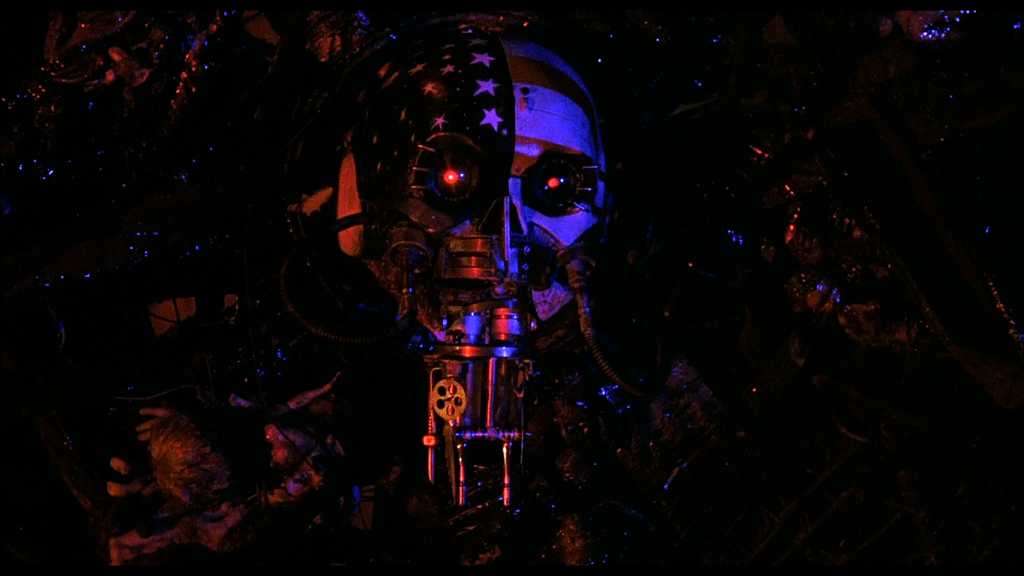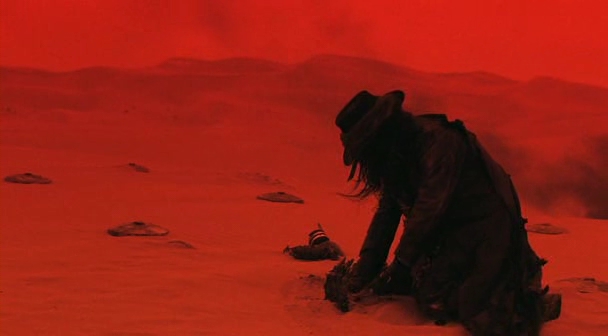Author: Andrew Carr
When Corehammer sounded the horn for people to write about cyberpunk, I knew I had to answer the call. Now, there is a wealth of amazing cyberpunk flicks out there and I was pretty spoiled for choice, so I decided to avoid the obvious classics and look at some of the more niche flicks out there. I considered the artier stuff (Burst City/Tetsuo: The Iron Man) and also the trash (Hands of Steel/Nemesis); however, I eventually decided on something that kind of sits in between and holds a special place in my miserable Lancastrian heart – Hardware.
I only found out about this film a few years back, as I was starting to discover all those movies whose VHS cover art I used to stare at longingly in the local Spar when I was about seven. Podcasts like The Gentlemen’s Guide To Midnite Cinema and The Cult Of Muscle reminded me of those glorious days, when Cliffhanger was next to Ninja III: The Domination and Coneheads was a couple of rows below. As a kid, I discovered cyberpunk through Judge Dredd, Rogue Trooper and the rest of 2000AD. This evolved in my teens into an interest in Cyberpunk 2020, sci-fi movies and an unhealthy obsession with Fear Factory. As an adult, this finally morphed into a love of genre cinema from the 80s and 90s which, strangely enough, brought me right back to those days spent staring up at copies of Nemesis that I could never reach…..
To set the scene: The future is royally fucked. The Earth is a rad-riddled desert, people live off the scrap of previous generations and the government wants to sterilize a load of the population. TV is shite, filled with adverts for reindeer steaks, weird art flicks starring Lou Reed and early Ministry being played over GWAR videos. Welcome to a world where goths scavenge wastelands, proto-punks rule the radio waves and Lemmy is a cabbie. Welcome to Richard Stanley’s Hardware.
Hardware is basically a futuristic home invasion flick, but with a fuck-off killer robot instead of a gang of criminals or creepy killer kids. Dylan McDermott plays the cocky, trench coat-clad future soldier Mo who, on coming back from a stint in the rad-wastes, picks up a gift for his girlfriend Jill (played by Stacey Travis). The gift in question is the skull of a maintenance robot that Carl McCoy from Fields of Nephilim picked up in a minefield out in “The Zone”, a big red desert that now makes up the majority of the planet. Jill’s an artist who specializes in metalwork, so the head is perfect for her latest masterpiece. We, the audience, are quickly informed via one of those oh-so-eighties green and black computer screens that the parts found were actually part of a M.A.R.K. 13 – a prototype killing machine that is loaded with everything from chainsaws to syringes full of poison that make the victim euphoric before making them very dead. Unfortunately for our stars, the fucker is still somewhat operational and also has the ability to rebuild itself from whatever parts it can find. This then leads to an amazing montage scene where our hapless heroine sleeps through the robot building a body out of scrap and testing out all of its weapons in a pokey one-bed flat.
 The film then focuses on Jill being stalked by the M.A.R.K. 13 in her apartment, while Mo tries to find out just what the fuck he bought her and then trying to save her along with his space pilot mate, Shades (John Lynch), who may or may not be just a bit in love with Jill. The tension is effectively ratcheted up during the scenes with Jill and the robot, with the big, ungainly metal psycho coming out of the shadows, from under furniture and even behind the curtains to give her a bit of murder death kill. Luckily for her, it always ends up being thwarted by the vid phone ringing, its thermal vision being worse than the Predator’s or its cable reaching maximum extension like some demonic vacuum cleaner. There’s also a sub-plot involving a super-sleazy peeping tom (an amazingly sweaty turn by William Hootkins AKA Porkins in Star Wars: A New Hope), who decides that going into the apartment of the woman he’s been harassing is a good idea. This has an awesome pay off and a song that will be stuck in your head for bloody ages. On top of that, Shades does a load of future drugs while meditating in front of a shrine dedicated to Vishnu, Robocop-style adverts play on the telly and Iggy Pop channels an especially coked-up Howard Stern as the radio DJ, Angry Bob. This eventually all culminates in an extended scene where the heroes fight back, someone gets chopped in half and things don’t exactly go to plan for Mo. Jill then goes all John J Rambo and the evil robot gets defeated by being stuck in a shower. Not even M Night Shyamalan would use that plot device… or no, wait he used it to ruin Signs.
The film then focuses on Jill being stalked by the M.A.R.K. 13 in her apartment, while Mo tries to find out just what the fuck he bought her and then trying to save her along with his space pilot mate, Shades (John Lynch), who may or may not be just a bit in love with Jill. The tension is effectively ratcheted up during the scenes with Jill and the robot, with the big, ungainly metal psycho coming out of the shadows, from under furniture and even behind the curtains to give her a bit of murder death kill. Luckily for her, it always ends up being thwarted by the vid phone ringing, its thermal vision being worse than the Predator’s or its cable reaching maximum extension like some demonic vacuum cleaner. There’s also a sub-plot involving a super-sleazy peeping tom (an amazingly sweaty turn by William Hootkins AKA Porkins in Star Wars: A New Hope), who decides that going into the apartment of the woman he’s been harassing is a good idea. This has an awesome pay off and a song that will be stuck in your head for bloody ages. On top of that, Shades does a load of future drugs while meditating in front of a shrine dedicated to Vishnu, Robocop-style adverts play on the telly and Iggy Pop channels an especially coked-up Howard Stern as the radio DJ, Angry Bob. This eventually all culminates in an extended scene where the heroes fight back, someone gets chopped in half and things don’t exactly go to plan for Mo. Jill then goes all John J Rambo and the evil robot gets defeated by being stuck in a shower. Not even M Night Shyamalan would use that plot device… or no, wait he used it to ruin Signs.
The film’s strongest aspect is its aesthetic. The environment is cluttered and dusty. All the tech looks out of date, with huge computers with those poxy little CRT screens and absolutely no VR. The M.A.R.K. 13 itself is a big, clunky bastard that looks like it wants to rip your innards out in a particularly messy way. This all perfectly captures the dirtier, more grimdark side of cyberpunk. There’s no neon or rain, just blood red skies, dust and blood. It’s almost post-apocalyptic, but it would need George Eastman riding around a quarry in a tricked-out dune buggy to tick that box. The MA.R.K. 13 itself is a big, clunky mess that looks like something out of ABC Warriors, which is rather apt, seeing as Hardware was based on the 2000AD short, SHOK. However, someone involved in the making of the film decided to omit that fact and this led to a court case which resulted in the original short story’s authors, Steve MacManus and Kevin O’Neill (who created the stupidly amazing Marshall Law with Pat Mills), eventually being added to the writing credits.
The film also has the typical messages you’d expect from cyberpunk: an oppressive but blindly accepted government, the impact of the media and one’s loss of humanity. However, their implementation is a bit crude and it ultimately lacks the impact Stanley was clearly hoping for. It also takes itself a bit too seriously at times and this, to me, is the film’s only real failing. If it had been lighter in tone, we would have had a fun, but mindless killer robot movie like Death Machine. If he’d gotten the implementation spot on, we could have had Blade Runner by way of Halloween. Regardless, the film is one hell of a ride that has some truly memorable moments. This is why Hardware has such a special place in my heart; it’s a trier. It’s full of ideas, shoots for the moon and only just misses its mark. Do yourself a favour, grab yourself a copy, crack open your beverage of choice and wallow in the grime.
This is what you want, this is what you get.


